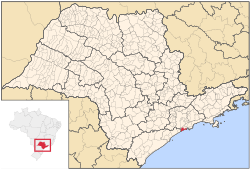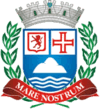Praia Grande
| Município da Estância Balneária de Praia Grande | |||
|---|---|---|---|
| |||
| Nickname(s): " Cidade de Todos " | |||
| Motto: Mare Nostrum "Our sea" | |||
 Location of Praia Grande | |||
| Coordinates: 24°00′22″S 46°24′10″W / 24.00611°S 46.40278°WCoordinates: 24°00′22″S 46°24′10″W / 24.00611°S 46.40278°W | |||
| Country |
| ||
| Region | Southeast | ||
| State |
| ||
| Government | |||
| • Mayor | Alberto Pereira Mourão (PSDB) | ||
| Area | |||
| • Total | 147.07 km2 (56.78 sq mi) | ||
| Elevation | 3 m (10 ft) | ||
| Population (2016)[1] | |||
| • Total | 304,705 | ||
| • Density | 2,100/km2 (5,400/sq mi) | ||
| Time zone | BRT (UTC-3) | ||
| • Summer (DST) | BRST (UTC-2) | ||
| HDI (2016) | 0.785 – high | ||
| Website | Praia Grande | ||
Praia Grande (Portuguese pronunciation: [ˌpɾajjaˈɡɾɐ̃dʒi] is a municipality in the state of São Paulo in Brazil. It is part of the Metropolitan Region of Baixada Santista.[2] The population is 299,261 (2015 est.) in an area of 147.07 km².[1]
Population history
| Year | Population |
|---|---|
| 2003 | 215,474 |
| 2004 | 229,542 |
| 2009 | 249,551 |
| 2010 | 260,769 |
| 2012 | 272,390 |
| 2013 | 288,401 |
| 2014 | 293,695 |
| 2015 | 299,261 |
History
Although the political emancipation is recent, the area covered today by the municipality of Praia Grande was one of the first areas colonized by the Portuguese, which began with the arrival of Martim Afonso in 1532 . The first village founded by the explorer, sent by the Portuguese crown, was that of St. Vincent, which remained part Praia Grande until 1967.
After emancipation, the city slightly accelerated the pace of growth experienced since the 1950s, earning a higher quality in their public services, given the proximity of the municipal government with the reality of the local population. In the 1980s, the city gained new impetus to its growth with the opening of the Small Sea Bridge (in the final stretch of the Highway of Immigrants), linking the island of Sao Vicente in the city, and solving two problems at once: as well as relieve traffic on saturated Suspension Bridge, the city gained a direct link to the capital without the need of going through the cities of Santos and Sao Vicente, in order to access the Via Anchieta,[3] then the only option to reach the capital. Thus, Playa Grande became the resort closest to the capital.
However, this ease of access has brought great inconvenience, that they would be solved by 1993 when the city started a revolution: the transport system has been completely refurbished, more than 90% of the streets were paved, the sewage began an expansion of collection (which began with 60% of households by 2012 and reach 100%), being treated and thrown more than 3 km from the coast, the edge of the beach and the main tourist spots were completely re-urbanized, it was forbidden to input bus tours without prior authorization from the municipality, the road system has been completely revised and reconfigured on interventions that occurred until 2006.
Some projects are still to be deployed in the city, regardless of the administration, such as airport charges in the region of Andaraguá, State college campuses (UNESP) and Federal (UNIFESP), the transformation of municipal landfill in ecological park (awaiting decontamination of the soil) and Route 700, linking the Anhanguera to Immigrants.
Demographics
Until the early 1990s, most residents lived near the Praia Grande beach, mainly concentrated in the region between the beach of Big hole, where is located the city center and beach Ocian. However, from the mid-1990s, the construction boom, which occurred through a series of infrastructure works, landscaping and urbanization, which until then were too poor, eventually attracting thousands of families in the municipality, search of jobs with contractors and builders, causing a huge swelling population in the region between the current South Expressway, the Highway Padre Manoel da Nóbrega and Serra do Mar creating suburbs, as Quiet Garden, Ribeiropolis, Garden Fern, among others, but now, since all are in the process of urbanization with schools, kindergartens, public transport and flooring in most of its streets, as well as future investments made by the city size at these sites, such as 16 million dollars to be invested in the suburb Glory, in its complete redevelopment.
Bathing Resort
Praia Grande is one of 15 cities considered spas by São Paulo state, which complied with certain prerequisites set by State Law. There are other cities that are not spas, they are still tourist resorts. This status ensures these municipalities a larger budget from the state through the Department of Field Support Offices of the State of São Paulo for the promotion of regional tourism. Also, the municipality acquires the right to add your name next to the title of Bathing Resort (Portuguese: Estância Balneária), term by which is designated by both the municipal official or expedient for the reference state.
Neighborhoods
Praia Grande is divided into three districts: the Main/Seat District, Samaná, in the highlands, and Solemar, near the border with Mongaguá.
The neighborhoods can be classified between coastal ones, which are located between the Padre Manoel da Nóbrega Highway and the beach, peripheral, located on the residential area between the highway and the Piaçabuçu river and its foothills, and the mountainous region of Samaná. Since 1992, each neighborhood has been identified with a different color, inserted in all public IDs for each district.
Also, some neighborhoods are subdivided into smaller regions called Administrative Squares, which once made more specific addresses, helping the service of the local post office, currently serving to group places that have features common to the municipal administration work in some specific need.
The municipality contains part of the 901 hectares (2,230 acres) Xixová-Japuí State Park, created in 1993.[4]
Infoway
Praia Grande was the first Brazilian city to install the Information Highway, a fiber optic interconnection of all municipal government offices, which resulted in more than 300 km of cables installed in the main streets and avenues. With this network was also possible to install more than 1,200 video cameras along the busiest places of the city as well as in public buildings and monuments. The entire city is monitored by these cameras, a central, directly interconnected with the Municipal Guard and the Military Police. Thus, rates of police incidents fell 60% and vandalism of public facilities in the city by 40%.
Today, Praia Grande is the city with the largest number of surveillance cameras in the Americas, and the second in the world, second only to London, United Kingdom. There is a program of installation, the next two years (from 2007), 900 more cameras, overtaking even London in the amount of cameras installed.
In addition to monitoring, the Infoway allows data access to any unit of municipal institutions, in real time. This facilitates, for example, medical care, because even before the patient hold the first consultation, the doctor will have access to the entire history of every patient in the care of the municipal health network, including by which medical specialties which there have been consultations, tests, prescription drugs, allergies, and everything else that is part of history.
References
- 1 2 Instituto Brasileiro de Geografia e Estatística
- ↑ Assembleia Legislativa do Estado de São Paulo, Lei Complementar Nº 815
- ↑ http://www.viagembem.net.br/turismo-em-sao-paulo/
- ↑ PES Xixová-Japuí (in Portuguese), ISA: Instituto Socioambiental, retrieved 2016-11-28
External links
- (in Portuguese) Baixada Santista
- (in Portuguese) http://www.praiagrande.sp.gov.br
- (in Portuguese) citybrazil.com.br
- (in Portuguese) PraiaGrande.com


